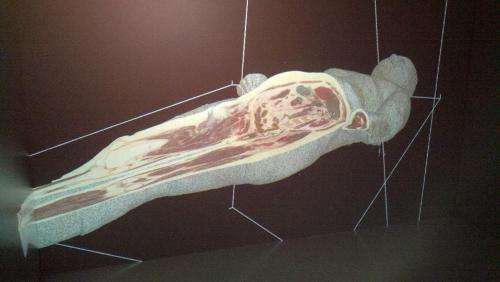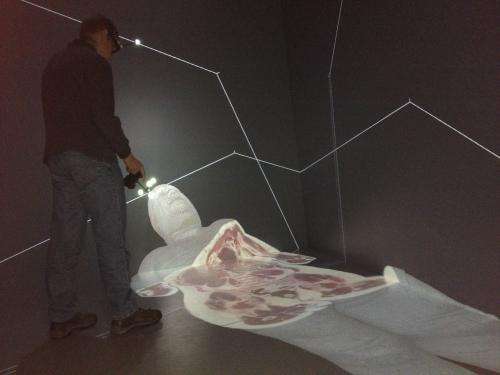Students virtually dissect hologram-like 3-D cadaver

(Phys.org) —The 3-D virtual reality cadaver floats in space like a hologram on an invisible gurney.
University of Michigan 3-D Lab employee Sean Petty stands a few inches away. Petty wears special glasses and pilots a joystick to arbitrarily slice away sections of the cadaver. He enlarges and turns the body for a better view of the detailed anatomy inside.
Alexandre DaSilva, assistant professor at the U-M School of Dentistry, called the virtual reality cadaver the opportunity of a lifetime for himself and for his dental students, residents and doctoral students working with the technology.
"The first time I saw the technology I almost cried," said DaSilva, who also heads the Headache and Orofacial Pain Effort at U-M Dentistry and the Molecular and Behavioral Neuroscience Institute. "In my wildest dream, I never thought that this would be possible."
The 3-D model supplements traditional anatomy class in several ways, DaSilva said. For instance, the residents can back up and redo cuts, and also enlarge areas to see them more closely.
"When you really immerse in the 3-D image, you can use all your senses," said Thiago Nascimento, a postdoctoral student in DaSilva's research lab. "It blew my mind."

Researchers at the U-M Medical School Visible Human Project had already layered the cadaver into very thin sections. The group shared the anatomical data with Petty and 3-D Lab colleague Theodore Hall. The two then wrote the code that reassembled the body into a computer model, said Eric Maslowski, manager of the 3-D Lab, which is part of the Digital Media Commons, a service of the library.
Maslowski said that other disciplines such as engineering or natural science can use the technology to virtually dissect simulated hurricanes or slice into Mastodons, for example. DaSilva uses it now to study 3-D brains of pain patients to learn about migraine and other disorders.
Provided by University of Michigan

















